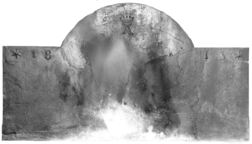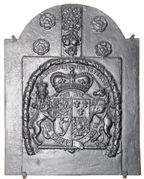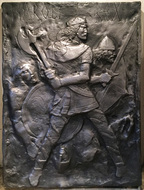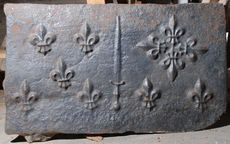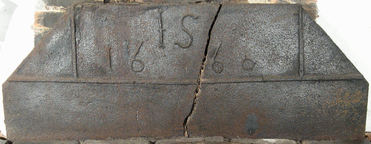-
506
Description: Plain rectangular shield with sloping edges; shield helm and crest of Sir Weetman Pearson Bt.: Per fess indented gules and or, between two suns in splendour in chief an escutcheon bearing a baronet's badge, and a demi-gryphon couped wings elevated and addorsed in base all counterchanged; crest: in front of a demi-gryphon as in the arms, holding between the claws a mill-stone proper, thereon a mill-rind sable, a sun in splendour.
Notes: Sir Weetman Pearson, later Viscount Cowdray, was created Baronet in 1894 and Baron in 1910, the fireback thus dates from the period 1894-1910. The motto - Do it with thy might - is from Ecclesiastes 9: 10.
Copies of this fireback are known.
Inscription: DO IT WITH THY MIGHT
Arms: Sir Weetman Pearson Bt
- Decoration tags:
- complex individual (shape)
- none (edging)
- whole carved pattern
- armorial
- text
Manufactured: in the late-19th century in England.
Current location: Parham House, Parham, West Sussex, England.
- Attached to series:
- Personal armorial firebacks
-
1293
Description: Rectangular shape; no edging; raised fillets along the top and bottom, and diagonally in both directions between them, upon each of which are embossed ANO DO ANO DO 1624, although the spacing differs on each fillet, the certainty of this repetition is concealed in some parts by indistinct casting, and in at least one instance a colon is inserted before the date. The inscription on the top edge is inverted. Behind the intersection of the two diagonal fillets is what might be a figure holding a linear object over its right shoulder.
Notes: Clearly intended to be commemorative although for what is not known. Its small dimensions indicate that could have been intended as a plaque rather than a fireback, although the indistinct inscription on the bottom edge could have resulted from corrosion by fire.
Inscription: ANO DO ANO DO [:] 1624 [x4]
- Decoration tags:
- rectangular (shape)
- none (edging)
- carved stamps
- individual letters
- individual numbers
- text
- humans
Manufactured: in 1624 possibly in the Weald area of England.
Current location: Parham House, Parham, West Sussex, England.
- Attached to series:
- Miscellaneous stamp firebacks
-
508
Description: Arched rectangular shape; no edging; top centre, crowned capital ‘A’; date divided at top corners of plate; single six-pointed star outside date.
Notes: Earl’s coronet denotes the Earl of Ashburnham, furnace owner; the furnace was blown out for the last time in late February 1813, this fireback being reputedly the last casting from a Wealden furnace. One of a small series of firebacks cast in the early-19th century for farms on the Ashburnham estate.
Inscription: * 18 A 13 *
- Decoration tags:
- rectangular with round arch (shape)
- none (edging)
- carved stamps
- individual letters
- individual numbers
- text
- objects
Manufactured: in 1813 at Ashburnham Furnace in the Weald area of England.
Current location: in private hands, Penhurst, East Sussex, England.
- Attached to series:
- Ashburnham late series
-
533
Description: Arched rectangular shape; fluted pilasters supporting a lintel with nine evenly spaced flowers arranged horizontally; central standing female figure, holding a basket of flowers, a child upon her back, another child by her side, and a sheep to her left; on top, a symmetrical arrangement of an anchor, two paddles and two cornucopiae.
Notes: The figure would seem to represent Charity. One of a series with a distinctly Empire style. Mitford collection, Petworth House.
- Decoration tags:
- rectangular with round arch (shape)
- none (edging)
- whole carved pattern
- pictorial
- allegorical
- animals
- humans
Manufactured: in the late-18th to early-19th century in France.
Current location: Petworth House, Petworth, West Sussex, England.
Museum number: NT/PET/M/86 (part of the National Trust museum group)
Citation: Carpentier, H., 1912, Plaques de Cheminées (Paris, published by the author).
- Attached to series:
- Miscellaneous pattern firebacks
-
535
Description: Arched rectangular shape; no edging; raised central square surmounted by Royal Arms of Great Britain and Ireland, with Garter, crown and lion and unicorn supporters; surrounded by a horseshoe-shaped, twisted floral wreath, within which the inscription is printed in capitals. Above the arms a raised rectangular fillet is surmounted by two suspended floral swags, one above the other, comprising roses and oak apples. On each side of the fillet are two Tudor roses, one above the other.
Notes: Dated to between 1714 and 1801. The inscription is the visible part of an abbreviated version of the formal title of the monarch, ‘By the Grace of God, of Great Britain, France and Ireland, King, Defender of the Faith, Duke of Brunswick and Lünenburg, Arch Treasurer and Prince Elector of the Holy Roman Empire’. Mitford collection, Petworth House.
Copies of this fireback are known.
Inscription: MAG BRIT FRA ET HIB REX F D BRUN ET LUN DUX / HONY SOIT QUI MAL Y PENSE
Arms: English Hanoverian royal
- Decoration tags:
- rectangular with round arch (shape)
- none (edging)
- whole carved pattern
- armorial
- royal
- text
- plants
Manufactured: in the 18th century in England.
Current location: Petworth House, Petworth, West Sussex, England.
Museum number: NT/PET/M/89 (part of the National Trust museum group)
- Attached to series:
- Hanoverian royal armorial firebacks
-
1065
Description: Rectangular; no edging; rough background with 'incised' inscription across top in archaic lettering; central crowned male figure, in Saxon costume, standing astride and facing right, holding a battleaxe to his right in both hands; behind him to the right, a figure wearing a Norman-style helmet with nasal guard, advancing, with a shield, and a sword in his right hand; behind the central figure and to his right, a fallen figure with a circular shield covering him; below, the face of another fallen figure, also wearing a Norman helmet.
Notes: A dramatic pictorial fireback commemorating the Battle of Hastings. The pattern may have been made of a sculpted medium, such as clay.
Inscription: HAROLD REX
- Decoration tags:
- rectangular (shape)
- none (edging)
- whole carved pattern
- pictorial
- text
- humans
- objects
Manufactured: in the 20th century in England.
Current location: Mark Ripley Forge & Fireplaces, Northbridge Street, Robertsbridge, Salehurst, East Sussex, England.
- Attached to series:
- Commemorative firebacks
-
660
Description: Rectangular; plain plate; central, vertical cross-hilt dagger stamp; left side, fleur de lys stamp repeated five times, irregularly arranged in three rows, two above and below and one in the middle; right side, fleur de lys stamp repeated six times, four in a star above two in a row.
Notes: The dagger (length approx. 35cm), seen on two other firebacks (no. 595 and no. 1100), may have beeen of Italian manufacture. The form of the fleurs-de-lys identifies this fireback as one of the ‘Royal’ series, a large group bearing heraldic stamps.
- Decoration tags:
- rectangular (shape)
- none (edging)
- simple stamps
- carved stamps
- heraldic
- objects
Manufactured: in the mid-16th century in the Weald area of England.
Current location: Hole Park, Rolvenden, Kent, England.
- Attached to series:
- Knife & Dagger stamp firebacks
- Royal series
- Fleur-de-lys firebacks
-
976
 ? x ? mm
? x ? mmDescription: Plain rectangular plate with detached pediment; central shield with motto scroll below.
Notes: The severe classical form suggests that this back may have been intended for attaching to a grate. Blazon: Tynte - Gules, a lion couchant between six cross-crosslets Argent; Kemeys - Vert, on a chevron Argent three pheons Sable.
Inscription: DYW DY RAS
Arms: Tynte quartering Kemeys
- Decoration tags:
- rectangular with detached pediment (shape)
- none (edging)
- whole carved pattern
- armorial
Manufactured: in the 18th century in Wales.
Current location: Cefnmabli, Rudry, Glamorgan, Wales.
- Attached to series:
- Personal armorial firebacks
-
675
Description: Quasi-arched rectangular shape; fillet edging; centre, fluted flower vase containing a variety of flowers, with a plant growing on each side, all within an arched rectangular bead-and-pellet border with looped top corners; on each side, a festoon of bell flowers, with a putto blowing a trumpet above; over each of their heads a single rose; top centre, a sunburst; bottom, an animal’s face between mirrored swirled foliage.
Notes: One of a small group of firebacks with similar outlines.
Copies of this fireback are known.
Manufactured: in the early- to mid-18th century in England.
Current location: Saffron Walden Museum, Saffron Walden, Essex, England.
Museum number: 1897-03 (part of the Saffron Walden Museum museum group)
- Attached to series:
- Late pictorial series (all)
- Late pictorial series 6
-
690
Description: Canted rectangle; plain edges; broad horizontal fillet dividing the plate in two just above the side angles, with vertical fillets to top corners enclosing date and initials.
Notes: Uncharacteristically crude for the period.
Inscription: IS / 16 60
- Decoration tags:
- rectangular with canted top corners (shape)
- none (edging)
- simple stamps
- individual letters
- individual numbers
- text
Manufactured: in 1660 in the Weald area of England.
Current location: Smallhythe Place, Small Hythe Road, Tenterden, Kent, England.
Museum number: 1117951 (part of the National Trust museum group)
- Attached to series:
- Date & initials firebacks


